SomnusNooze
We are thankful to be able to keep in contact with our community through social media, email, and SomnusNooze. If you’ve missed any of the latest news we’ve shared, don’t worry! Get up to date with this latest edition of “In Case You Missed It!”
- NEWLY RELEASED VIDEO: Watch the Hypersomnia Foundation virtual educational event—“The Research Continues”
- MUST READ: Xywav or Xyrem—What’s the Difference?
- NOW RECRUITING: Adelphi Values seeking participants with IH for qualitative health research study
- RECENTLY PUBLISHED: Two interesting articles on hypersomnolence by Dr. Lynn Marie Trotti
- PERSONAL JOURNEY: I am Not ‘Lazy’, I Have a Sleeping Disorder
- CONGRATULATIONS: Dr. Mandeep Singh receives the SASM 2020 Presidential Scholar Award
- INTERESTING READ: Solving the mystery of why we sleep and how sleep works in the brain
So don’t worry if you’ve missed anything. We’ve got you covered!
NEWLY RELEASED VIDEO! “THE RESEARCH CONTINUES”, HF’s VIRTUAL EDUCATIONAL EVENT
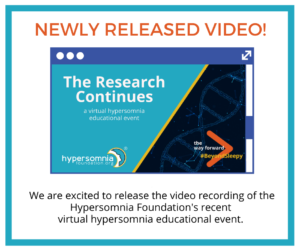 We are excited to release the video recording and PowerPoint slides of the Hypersomnia Foundation’s recent virtual hypersomnia educational event, “The Research Continues.”
We are excited to release the video recording and PowerPoint slides of the Hypersomnia Foundation’s recent virtual hypersomnia educational event, “The Research Continues.”
Recorded sessions include:
- HF Research Award Recipient Dr. Caroline Maness provides an update on her research “Cytokine Profiles in the Central Disorders of Hypersomnolence” and participates in a live Q&A with viewers.
- HF Research Award Recipient Dr. Todd Bishop, provides an update on his research “Hypersomnia and Our Heroes: Studying IH and Behavioral Disorders in the U.S. Veteran Population” and participates in a live Q&A with viewers.
- Christina Brundage, Hypersomnia Foundation Volunteer and IH Patient Advocate shares her personal experiences in “Christina’s Story: Volunteering for IH Clinical Trials”.
Watch and share with family and friends and be sure to check out our other videos and podcasts.
U.S. FDA GRANTS FAST TRACK DESIGNATION TO NEW MEDICATION FOR IDIOPATHIC HYPERSOMNIA
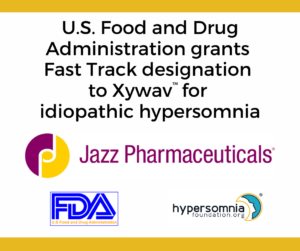 Jazz Pharmaceuticals announced positive top-line results from the Phase 3 double-blind, multicenter, placebo-controlled, randomized withdrawal study evaluating the efficacy and safety of an investigational use of Xywav™ (calcium, magnesium, potassium, and sodium oxybates) oral solution in adult patients with idiopathic hypersomnia.
Jazz Pharmaceuticals announced positive top-line results from the Phase 3 double-blind, multicenter, placebo-controlled, randomized withdrawal study evaluating the efficacy and safety of an investigational use of Xywav™ (calcium, magnesium, potassium, and sodium oxybates) oral solution in adult patients with idiopathic hypersomnia.
“We are excited by these compelling results and the magnitude of improvement observed in the study, in particular for people living with idiopathic hypersomnia who currently have no approved treatment option. We are deeply grateful to the patients and investigators who participated in the study, and look forward to working quickly with the FDA to make Xywav available to patients as soon as possible,” said Robert Iannone, MD, MSCE, executive vice president, research and development of Jazz Pharmaceuticals.
Read more about this exciting development! For information on currently-recruiting and ongoing clinical trials and research studies, and results from past studies, visit our website’s research studies pages.
XYWAV OR XYREM: WHAT’S THE DIFFERENCE?
 For more than a decade and a half, Xyrem has been prescribed to patients with narcolepsy who experience cataplexy or excessive daytime sleepiness. It was the only U.S. Food and Drug Administration-approved therapy for the treatment of cataplexy. Xyrem has demonstrated efficacy for narcolepsy management, but each milliliter of the oral solution contains 91 mg of sodium.
For more than a decade and a half, Xyrem has been prescribed to patients with narcolepsy who experience cataplexy or excessive daytime sleepiness. It was the only U.S. Food and Drug Administration-approved therapy for the treatment of cataplexy. Xyrem has demonstrated efficacy for narcolepsy management, but each milliliter of the oral solution contains 91 mg of sodium.
For nearly a decade, scientists have been working to create a lower-sodium narcolepsy therapy that would be as efficacious as Xyrem. Jazz Pharmaceutical has been successful with the newly FDA-approved therapy Xywav—an oral solution with 92% less sodium than Xyrem.
“A low-sodium diet is an important part of the health of everyone, but especially for patients with narcolepsy, who are known to have increased cardiovascular risk factors,” says Rob Iannone, MD, Executive Vice President, Research and Development at Jazz Pharmaceuticals. “It’s critically important that sleep physicians are as informed as possible about cardiovascular risks that narcolepsy patients have and the potential negative effects of a high-sodium intake.”
For more details about Xywav verses Xyrem, read this recent article from “Sleep Review Magazine.”
Remember to check out the “Treatments” page of our website. Get information about prescription medication affordability in the U.S., medications that are FDA-approved for sleepiness and FDA-approved for cataplexy, and medications that are not FDA-approved for sleepiness but are sometimes used for sleepiness in people with narcolepsy and other hypersomnias. You will also find information about novel and emerging treatments for sleepiness in primary hypersomnias.
PARTICIPANTS NEEDED FOR A QUALITATIVE HEALTH RESEARCH STUDY ON LIVING WITH IH
 Adelphi Values is working with a major pharmaceutical firm conducting a qualitative health research study for idiopathic hypersomnia (IH) and is currently recruiting adults age 18-75, who have idiopathic hypersomnia to participate in a one-on-one 90-minute telephone interview to discuss your experience living with IH, how it affects your life, and to get your feedback on an IH patient questionnaire.
Adelphi Values is working with a major pharmaceutical firm conducting a qualitative health research study for idiopathic hypersomnia (IH) and is currently recruiting adults age 18-75, who have idiopathic hypersomnia to participate in a one-on-one 90-minute telephone interview to discuss your experience living with IH, how it affects your life, and to get your feedback on an IH patient questionnaire.
You will receive $150 for completing the 90-minute interview. You may qualify to participate in this study if you:
- are between 18 and 75 years of age;
- have a clinician confirmed diagnosis of IH and are able to provide documentation confirming diagnosis;
- have an average nightly total sleep time of 7 hours or more;
- do not have other sleep related disorders such as sleep apnea or parasomnia;
- are fluent in English.
No medication will be given or tested as part of this study.
If interested in participating, call (617) 720-0001 and ask for Samantha Power to obtain additional information about the study and to have any questions you may have about the study answered; or email and reference study number JZ8725A.
Please note:
- Additional exclusions may apply for participation in this study. Please contact Adelphi Values to learn more.
- Your participation in the interview does not replace and will not affect any treatment or assistance that you currently receive or may receive in the future.
- Your name and contact information will remain confidential and will not be shared with anyone.
For more information about this and other currently recruiting and ongoing studies, check out our research studies pages.
RECENTLY PUBLISHED ARTICLES ON HYPERSOMNOLENCE
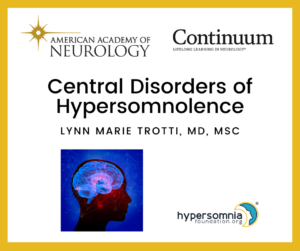 Dr. Lynn Marie Trotti, Emory University neurologist and Chair of the Hypersomnia Foundation Medical Advisory Board, recently published a comprehensive journal article, “Central Disorders of Hypersomnolence”, describing the symptoms, diagnosis and treatment of central hypersomnias, including IH.
Dr. Lynn Marie Trotti, Emory University neurologist and Chair of the Hypersomnia Foundation Medical Advisory Board, recently published a comprehensive journal article, “Central Disorders of Hypersomnolence”, describing the symptoms, diagnosis and treatment of central hypersomnias, including IH.
Both patients and providers can easily find and access Dr. Trotti’s article by using a link on two of our web pages. Visit the “Treatments” section of our website and scroll to “Further Information > Free Full Text Journal Articles” or on our “Healthcare Provider” page, scroll to the “Resources for Diagnosis” section and click on the title of Dr. Trotti’s article. [[2021 April Addendum: Unfortunately, this article is no longer available free full text. On the Treatment page, it has therefore been moved to the References section.]]
Dr. Trotti also coauthored an abstract published in a recent edition of the journal “Sleep”, which finds different patterns of metabolic activity in narcolepsy and idiopathic hypersomnia. According to the abstract, Emory University researchers found that functional imaging of the brain could shed light on the underlying disease in hypersomnolence disorders and these results imply disease-specific activity rather than non-specific sleepiness.
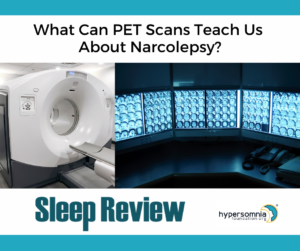 “PET [positron emission tomography] imaging doesn’t have a role in the clinical evaluation of narcolepsy type 1 (or idiopathic hypersomnia) right now. But these types of studies may help advance our scientific understanding of these disorders in ways that ultimately advance clinical care,” says Dr. Trotti. “We’re not to the point of applying this clinically, but there is so little that is known about the biology of idiopathic hypersomnia that I hope this will be one piece of a much larger puzzle that leads to better treatment options.”
“PET [positron emission tomography] imaging doesn’t have a role in the clinical evaluation of narcolepsy type 1 (or idiopathic hypersomnia) right now. But these types of studies may help advance our scientific understanding of these disorders in ways that ultimately advance clinical care,” says Dr. Trotti. “We’re not to the point of applying this clinically, but there is so little that is known about the biology of idiopathic hypersomnia that I hope this will be one piece of a much larger puzzle that leads to better treatment options.”
Dr. Trotti explains that future research is needed to better understand how this information can be used in clinical settings.
I AM NOT ‘LAZY’, I HAVE A SLEEPING DISORDER
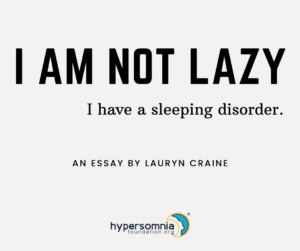 Writer Lauryn Craine tells her personal story of being a student with an undiagnosed sleeping disorder. From a teacher forcing her to stand up through her entire class so she wouldn’t fall asleep during the lectures to her struggles to stay awake while taking her SAT, Lauryn’s journey is very relatable.
Writer Lauryn Craine tells her personal story of being a student with an undiagnosed sleeping disorder. From a teacher forcing her to stand up through her entire class so she wouldn’t fall asleep during the lectures to her struggles to stay awake while taking her SAT, Lauryn’s journey is very relatable.
Lauryn shares that her diagnosis of Idiopathic Hypersomnolence finally validated that she wasn’t lazy. Sleeping in every class period was her body crying out that something was wrong.
Read Lauryn’s essay “I am Not ‘Lazy’, I Have a Sleeping Disorder” and share it with family and friends. It may help someone better understand what you or someone you care for is going through.
DR. MANDEEP SINGH RECEIVES SASM’s 2020 PRESIDENTIAL SCHOLAR AWARD
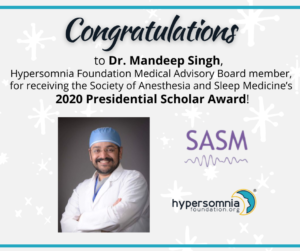 Congratulations to Dr. Mandeep Singh, Hypersomnia Foundation Medical Advisory Board member, for receiving the Society of Anesthesia and Sleep Medicine’s 2020 Presidential Scholar Award! Dr. Singh is certified in Anesthesiology and Sleep Medicine and completed a Masters in Clinical Epidemiology and Health Sciences Research at the University of Toronto.
Congratulations to Dr. Mandeep Singh, Hypersomnia Foundation Medical Advisory Board member, for receiving the Society of Anesthesia and Sleep Medicine’s 2020 Presidential Scholar Award! Dr. Singh is certified in Anesthesiology and Sleep Medicine and completed a Masters in Clinical Epidemiology and Health Sciences Research at the University of Toronto.
Congratulations, Dr. Singh for your continued work in the field of sleep medicine and research!
SOLVING THE MYSTERY OF WHY WE SLEEP AND HOW SLEEP WORKS IN THE BRAIN
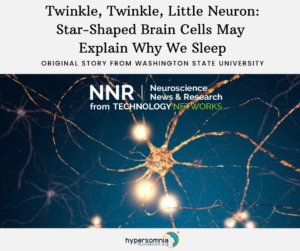 A new study published in the journal “Current Biology” suggests that star-shaped brain cells known as astrocytes could be as important to the regulation of sleep as neurons, the brain’s nerve cells.
A new study published in the journal “Current Biology” suggests that star-shaped brain cells known as astrocytes could be as important to the regulation of sleep as neurons, the brain’s nerve cells.
Led by researchers at Washington State University’s Elson S. Floyd College of Medicine, the study builds new momentum toward ultimately solving the mystery of why we sleep and how sleep works in the brain. The discovery may also set the stage for potential future treatment strategies for sleep disorders and neurological diseases and other conditions associated with troubled sleep, such as PTSD, depression, Alzheimer’s disease, and autism spectrum disorder.
“The findings of our study suggest that we may have been looking in the wrong place for more than 100 years,” said senior author and professor of biomedical sciences Marcos Frank. “It provides strong evidence that we should be targeting astrocytes to understand why and how we sleep, as well as for the development of therapies that could help people with sleep disorders and other health conditions that involve abnormal sleep.”
